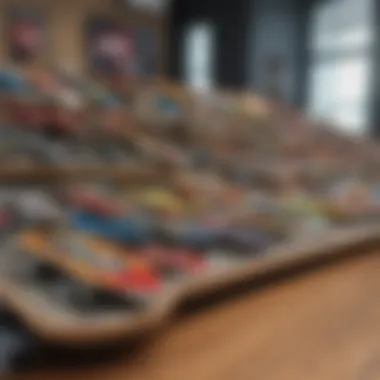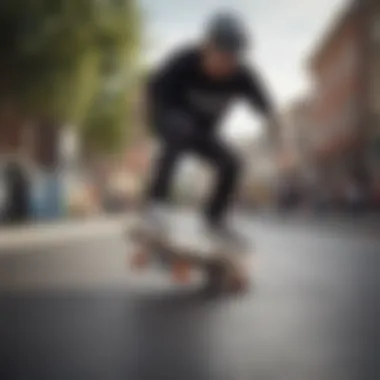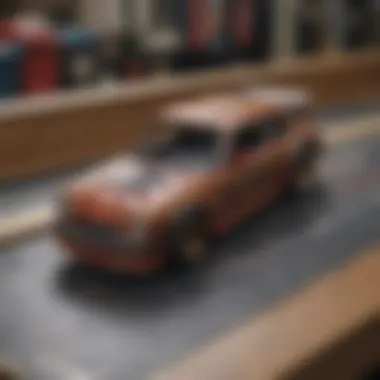Exploring the Tech Deck Community: An In-Depth Analysis


Intro
In recent years, the Tech Deck community has emerged as a focal point for skateboarding enthusiasts of all ages. These miniature skateboards, often no longer just toys but symbols of a broader culture, have captivated a diverse group of fans. From kids stacking mini ramps in their living rooms to adults customizing their setups to showcase artistic flair, Tech Decks have firmly planted themselves in the hearts of skateboard lovers.
The journey of Tech Decks began with their launch in the late 1990s when they were primarily marketed to children. However, what was meant as a simple toy quickly evolved into an engaging community fostering creativity, skill, and camaraderie among its members. Today, this miniature skateboarding movement stretches beyond mere tricks and stunts; it embodies a rich legacy of creativity and connection.
As we dive deeper into the Tech Deck culture, we'll illuminate various aspects—from fundamental skateboarding techniques to the nuances of community engagement. This exploration is designed not only to be informative but also to inspire both novices and seasoned skaters alike.
Skateboarding Techniques
Mastering Tech Decks, while seemingly straightforward, requires a blend of practice and finesse. Understanding the fundamental skills and advanced techniques can open a world of possibilities, allowing users to express their skateboarding style fully.
Essential Tricks for Beginners
Starting with Tech Decks can feel a bit like trying to ride a bike for the first time. You’re bound to tip a few times before finding your balance. Here are some vital tricks that beginners can focus on:
- Ollie: This basic trick involves popping the tail of the skateboard down and dragging the front foot up to allow the board to jump off the ground.
- Kickflip: A step up from the Ollie, the kickflip requires you to flick your front foot off the side after the jump, causing the board to spin mid-air.
- Heelflip: Similar to the kickflip, but using the heel instead to achieve the flip.
It’s crucial to practice these tricks on a flat surface. Over time, with repetition, they’ll become second nature.
Advanced Maneuvers for Seasoned Skaters
For those with some experience under their belt, diving into advanced techniques can be incredibly rewarding. Mastery leads to experimentation, and that’s where true creativity lies. Here are some sophisticated moves to challenge your skills:
- 360 Flip: Combining an Ollie and a kickflip, this trick involves rotating the board 360 degrees while simultaneously flipping it.
- Smith Grind: This is executed on coping or ledges where the back of the board grinds while the front is slightly elevated.
- Noseblunt Slide: An artistic move wherein the front wheels slide on an obstacle while the back of the board hangs off.
As you progress, don’t be shy to alter these tricks in ways that reflect your personal style. Always remember, practice makes a perfect.
Skate Culture
The foundation of the Tech Deck community is deeply embedded in the broader skate culture. Understanding its evolution and community dynamics can greatly enhance the experience of being a Tech Deck enthusiast.
The Evolution of Skateboarding Styles
The history of skateboard styles is fascinating. From the early days of vert and street skating, styles have morphed to include tech-centric and freestyle approaches. Each skater brings their unique flair, helping to shape the genre. Eric Koston and Rodney Mullen are just a couple of names that highlight how style has transformed over the decades, leading to the ever-popularization of street skating amidst urban landscapes.
Community Engagement and Local Events
Participating in Tech Deck events can often provide a sense of belonging to the community. Local competitions or meet-ups frequently foster networking, skill sharing, and even the opportunity to showcase individual styles.
A diverse online presence exists to facilitate this, from forums on Reddit where tricks are discussed, to Facebook groups where enthusiasts share their custom sets and techniques.
The Tech Deck community thrives on connection—whether it's through shared creativity, competitions, or simply swapping tips on customizing decks.
The importance of community can’t be overstated. Engaging with fellow fans not only develops your skills but keeps the innovative spirit alive within the Tech Deck culture.
This comprehensive guide aims to bridge the gap, making the vibrant world of Tech Decks accessible to everyone.
Preface to Tech Decks
In recent years, the Tech Deck community has gained significant traction, developing into a unique cultural phenomenon among enthusiasts of all ages. This article serves as a portal into that world, exploring the nuances that make Tech Decks more than just miniature skateboards. As we embark on this exploration, it becomes clear that understanding Tech Decks encompasses elements like the shared experiences within the community, the artistry involved in collecting and customizing, and the vital skills one can develop along the way.
Tech Decks aren't merely toys; they represent a convergence of creativity, skill, and passion for skateboarding. For skaters, they provide a chance to practice tricks without the physical constraints of a full-size skateboard. For collectors, the rich history and variety of designs add layers of interest. Furthermore, as we delve into the various aspects surrounding Tech Decks, it becomes evident how they facilitate connection and collaboration among users.


Understanding What Tech Decks Are
Tech Decks are tiny replicas of real skateboards, usually around four inches in length, designed for fingerboarding. These little boards allow users to execute a variety of tricks that mimic those done on full-sized skateboards. They often feature graphics from popular skateboard brands, making them attractive not just for play but also for collecting. Fingerboards, like Tech Decks, offer a unique blend of sport and artistry, merging the thrill of skateboarding with the intricate details of craftsmanship. The appeal lies in their accessibility, allowing anyone from beginners to seasoned pros to enjoy the essence of skateboard culture without needing an actual board.
Tech Decks come equipped with a myriad of features: various wheel designs for performance, diverse shapes to replicate different styles, and customizable components. This adaptability makes them popular among hobbyists and collectors alike, paving the way for a rich culture centered around creativity and skill mastery.
A Brief History of Tech Decks
The origins of Tech Decks can be traced back to the late 1990s when fingerboarding first started to gain traction. Initially, these small skateboards were simple toys, but over time, they evolved due to rising interest. Companies like X-Concepts capitalized on this trend by producing high-quality fingerboards modeled after real skate brands and skateboarding icons, allowing fans to experience the sport in a portable format.
As fingerboarding grew in popularity, Tech Decks quickly became synonymous with this niche. With innovative marketing strategies, various editions and collaborations began to emerge. The introduction of limited editions resulted in a vibrant collector's market, enabling enthusiasts to hunt for rare boards and fostering a community around their shared passion.
In essence, the journey of Tech Decks parallels that of skateboarding itself. Both realms have experienced ups and downs, yet the fundamental appeal lies in the freedom of expression and the creativity they promote. Today, Tech Decks continue to thrive, with countless users sharing their love for fingerboarding both online and offline, solidifying their place within skate culture as a whole.
The Rise of Tech Deck Culture
The rise of Tech Deck culture is more than just a trend; it's a testament to the ways in which miniature skateboarding has woven itself into the fabric of both skateboarding enthusiasts and casual hobbyists alike. This section delves into how Tech Decks have not only influenced personal skill development but also shaped social interactions within the skateboarding community. By analyzing the cultural relevance and community-building aspects, we can see why Tech Decks have become a phenomenon that extends well beyond simple toys.
How Miniature Skateboarding Became Popular
Miniature skateboards, particularly Tech Decks, didn't just appear on the scene by chance. The allure of these tiny boards can be traced back to their practicality and the growing popularity of skateboarding itself. In the late 90s and early 2000s, as various skateboarding styles and tricks began to flourish, the introduction of Tech Decks offered a way for fans to engage with the culture whether they were on the go or couldn't access a skateboard.
Consider this: imagine a kid in a classroom, instead of doodling during math class, practicing tricks on a Tech Deck in their hands. This relatable scenario explains how these little boards became symbolic of skate culture. With a variety of designs and brands like Element and Birdhouse, collectible models arrived. Social media soon took notice, as users showcased their skills through videos on platforms like Instagram and TikTok, fuelling the rise of miniature skateboarding's popularity.
Tech Deck in Relation to Skateboarding
While Tech Decks may be miniatures, their impact is immense when you look at how they reflect actual skateboarding. Think about it: the same tricks skaters perform on their larger boards can be mimicked on Tech Decks. This practice serves as an accessible way for enthusiasts to learn and master moves before attempting them in real life. Importantly, Tech Decks provide a great opportunity for skaters to foster their creativity. Skills developed on these tiny boards often translate into legitimate techniques once they hit the skatepark.
Furthermore, Tech Decks play a significant role in introducing newcomers to the world of skateboarding. They lower the entry barrier, allowing people who may feel intimidated by full-size skateboards to grasp the basic concepts. Just as well, it creates a unique bond among users—sharing tips and tricks creates a common language and connection among skaters, regardless of skill level.
"Embracing Tech Deck culture means embracing the spirit of skateboarding itself—it's about creativity, community, and, most importantly, fun."
In essence, the relationship between Tech Decks and traditional skateboarding demonstrates that these miniature boards do more than just replicate reality. They enrich the experience, opening doors for conversation, learning, and connectedness, making the world of skateboarding accessible to everyone.
With the rise of Tech Deck culture, it’s evident that tiny skateboards carry a significant weight in building bridges between different skateboarding communities, promoting engagement and a shared love for the sport.
Collecting Tech Decks
Collecting Tech Decks has become a vibrant aspect of the miniature skateboarding world, embodying a mix of creativity, nostalgia, and community spirit. It’s more than just amassing tiny skateboards; it’s about embracing the culture and artistry embedded in each piece. For skaters and enthusiasts alike, the act of collecting serves several purposes, from personal expression to creating a network with other fans. Some might view it as a hobby, while others see it as an investment opportunity.
Engaging in this collection journey allows individuals to delve into the history and evolution of skateboarding itself. It opens doors to understanding the various styles, manufacturers, and the artists behind these eye-catching designs. The broad variety available means collectors often find themselves not just gathering Tech Decks, but also curating a unique personal collection that reflects their taste and experiences.
Types of Tech Decks Available
When it comes to the types of Tech Decks on the market, the options are aplenty, each with its own unique features and appeal. The diversity caters to different preferences, ensuring there’s something for everyone. Here’s a closer look at the main types:
- Standard Tech Decks: These are the classic models, perfect for beginners and those looking to start their collection. They typically come with basic designs and are widely available.
- Pro Models: As the name implies, these are modeled after real-life skateboarders and their actual boards. They tend to be more detailed and represent popular skaters, making them sought after by many.
- Limited Editions: These Tech Decks are produced in smaller batches and can be highly collectible. Often featuring exclusive artwork or collaborations, they can capture the interest of dedicated fans.
- Custom Boards: Some collectors opt to personalize their Tech Decks, modifying them with unique designs, grip tape, or even paint. This not only showcases individual creativity but also allows collectors to stand out.
By understanding the types of Tech Decks available, collectors can make informed decisions when growing their collections.
Limited Editions and Their Value
Limited edition Tech Decks often hold a particular allure for collectors. These editions are typically released in small quantities, providing an element of exclusivity. The initial excitement around these pieces can make their value skyrocket among fans and collectors alike.
Furthermore, the value of a limited edition Tech Deck often appreciates over time. Factors such as the popularity of the skater it represents, the condition of the board, and the rarity can all play critical roles in determining how much these pieces might fetch on the resale market. Collectors who maintain their boards in pristine condition might find themselves sitting on a little gold mine down the road.


"The thrill of the hunt and the anticipation of finding a rare piece is unmatched in the collecting world."
Additionally, engaging with fellow collectors through online platforms like Reddit, Facebook, or specialized forums further enhances the experience. Sharing tips and insights about the current hot items or even swapping boards can add a layer of community interaction that enriches the hobby itself.
Customization and Personalization
Customization and personalization may seem like just creative outlets, but they play a pivotal role in the Tech Deck community. These practices allow skaters to express individuality, showcase skills, and enhance their connection to this miniature skateboarding world. Whether it's swapping out wheels or adding custom graphics, each modification tells a story about the skater's personality and preferences. This not only makes each Tech Deck unique but also creates an inclusive environment where enthusiasts feel a sense of belonging.
In a culture heavily influenced by self-expression, personalizing Tech Decks becomes an avenue for creativity. When skaters modify their boards, they engage in a hands-on activity that reinforces their skills and boosts confidence. This engagement fosters a deeper appreciation for the craft, merging artistry and skating into a delightful hobby.
Moreover, customization can serve practical purposes. It might enhance the performance features of the Tech Deck, allowing skaters to fine-tune their setups for certain tricks or styling preferences. In the grand scheme of things, these choices significantly affect their skating experience, reinforcing why such personalization is cherished in the community.
Common Tech Deck Modifications
Tech Decks are remarkably versatile and can undergo a host of modifications. Here are some common changes skaters often make:
- Wheels: Swapping out wheels for different hardness levels or colors impacts both performance and aesthetic appeal.
- Trucks: Adjustments in truck height or quality influence stability and maneuverability, helping the skater achieve specific tricks with more finesse.
- Grip Tape: Adding or replacing grip tape enhances control while showcasing unique designs, allowing for more creativity on the surface level.
- Deck Designs: Applying custom stickers or decals personalizes the look of the Tech Deck, reflecting the skater’s identity.
- Paint: Some skilled hobbyists take it a step further, using spray paint to create intricate designs or vibrant colors that make their boards stand out.
By experimenting with these elements, skaters cultivate a deeper connection with their decks, making every session feel distinctly their own.
Techniques for Unique Designs
Creating unique designs isn’t just about aesthetics; it’s a craft that showcases a blend of skill and vision. Here are some techniques that can help skaters achieve standout customization:
- Stencils: Using stencils allows for clean lines and shapes, which can dramatically elevate the visual appeal of the board.
- Airbrushing: This technique offers a smooth, professional finish, allowing for gradients and detailed artwork that can't be achieved with traditional painting methods.
- Hydro Dipping: A method where the design is printed on water's surface and then transferred to the Tech Deck, yielding eye-catching patterns that mesmerize onlookers.
- Vinyl Wraps: These are perfect for intricate or multi-colored designs, as they can be easily applied, removed, and replaced without damage to the original surface.
- Personal Symbols: Adding personal symbols or motifs can infuse a layer of meaning into the design. This trend, relating back to identity and background, is popular in the community.
In summary, the boundaries of customization are limited only by the skater’s creativity and willingness to experiment. Every Tech Deck stands as a canvas, waiting for inspiration to bring it to life.
Skill Development Using Tech Decks
Engaging with Tech Decks is not just about having fun; it’s an avenue for personal growth and skill enhancement that resonates deeply with both novice and experienced skaters. The beauty of these miniature skateboards lies in their ability to mimic real-life skateboarding maneuvers, thus allowing users to develop important skills that can eventually transfer to the larger board. As one delves into the world of Tech Decks, a variety of specific elements come into play that underline their significance in skill development.
The practice of performing tricks on Tech Decks sharpens motor skills, hand-eye coordination, and balance. While they may be smaller in size, the mechanics involved in executing tricks like ollies or kickflips are strikingly similar to those on a full-sized skateboard. By refining these tricks on a Tech Deck, skaters can build their confidence before attempting them in real life. This progression acts as a safety net, where skaters of all levels can experiment without the fear of falling hard or injuring themselves.
Fundamental Tricks to Master
Mastering fundamental tricks on a Tech Deck is the cornerstone of skill development. Below are some key tricks that should be on every enthusiast’s list:
- Ollie: Essential for jumping over obstacles, the ollie is the foundation for most other tricks. It teaches the fundamental balance and timing needed for any skateboard maneuver.
- Kickflip: After conquering the ollie, the kickflip is a natural next step. It requires not just board control but also finesse with foot placement.
- Heelflip: Similar to the kickflip but with a twist, the heelflip challenges skaters to adapt their movements and foot work.
- Grinds (Smith grind, Feeble grind): Grinds introduce the skater to rail and ledge tricks that enhance balance skills while performing on edge surfaces.
These tricks are not simply for show; they build an understanding of physics at play. When a skater attempts to launch off a small elevation or land from a trick, it involves coordination, force, and timing. Over time, as they conquer each trick, their confidence grows, creating a solid foundation for progressing.
Parallel Skills for Actual Skateboarding
The beauty of practicing on a Tech Deck is that it transcends the miniature realm and mirrors actual skateboarding in unexpected ways. Key parallels can enhance real-world skating skills:
- Balance: Tech Decks provide an excellent platform for practicing balance. Learning the nuances of staying centered while performing tricks on a small board directly transfers to a real skateboard.
- Foot Placement: Precision in foot positioning is critical. Using a Tech Deck helps to refine the ability to position feet correctly for optimal performance on a full-sized board.
- Control: While navigating with a Tech Deck, users learn subtle movements and adjustments to maintain control, a skill that’s equally important when on larger boards.
- Reaction Time: The quick nature of Tech Deck tricks helps develop sharp reflexes, which aids skaters when responding to obstacles or sudden changes in their environment on an actual board.
"Practice makes perfect; with Tech Decks, you can master your moves before hitting the pavement."
By honing these skills on a Tech Deck, skaters can gain an upper hand when they finally transition to actual skateboarding. The practices translate seamlessly into their full-sized counterparts, making the leap less daunting and more enjoyable. In summary, Tech Decks serve not just as toys but vital tools for developing essential skating skills that enrich the entire skateboarding experience.
Community Engagement and Online Platforms


Tech Decks have carved a niche in the skateboarding community, offering enthusiasts not just a hobby, but a vibrant space for expression and connection. The significance of community engagement cannot be overstated. This section looks into how online platforms play a crucial role in fostering this community spirit, allowing skaters to share their skills, learn from others, and participate in events that fuel their passion. The internet has created a unique tapestry of interactions that transcend geographical boundaries, connecting individuals with a shared love for Tech Decks.
Popular Platforms for Sharing Skills
From YouTube tutorials to Instagram showcases, the internet overflow with platforms where users can share their Tech Deck tricks and customizations. Some notable ones that come to mind include:
- YouTube: A treasure trove for learners. Here, you can find everything from simple how-to videos for basic tricks to advanced tutorials on intricate combinations. This platform also allows viewers to engage with creators, asking questions and offering tips of their own.
- Instagram: With its visual-centric approach, Instagram has become a go-to for showcasing creativity. Users post short videos demonstrating skills or photos of their latest custom designs, prompting comments and advice from fellow enthusiasts. Using hashtags like #TechDeck and #SkateCulture connects users with similar interests.
- Reddit: The subreddit r/techdeck serves as a forum where skaters share their journeys, challenges, and accomplishments. It's a place where advice flows freely, and community members celebrate each other's successes. The platform's threaded discussions create an environment rich in interaction and support.
- Facebook Groups: Various groups dedicated to Tech Deck collectors and enthusiasts allow users to share their collections, swap tips, and organize local meetups. These communities often foster a tight-knit atmosphere where members can forge lasting friendships through their shared interests.
These platforms serve vital roles in tearing down barriers between beginners and experienced skaters. Engaging in discussions, watching others perform, and receiving feedback creates an invaluable learning environment for all involved.
Participating in Tech Deck Events
Events dedicated to Tech Decks serve as a catalyst for community engagement, inviting participants to come together, share knowledge, and celebrate their mutual interests. These gatherings can take various forms:
- Competitions: Local and online competitions provide a stage for skaters to showcase their skills. Whether it's a best trick contest or a design challenge, these events not only test abilities but also foster camaraderie among participants.
- Workshops: Many enthusiasts and skilled individuals host workshops, teaching others about different modifications or tricks. These sessions can range from beginner basics to advanced techniques, enriching the collective knowledge of the community.
- Meetups: Organized meetups allow skaters to connect in person, share tips, and trade collectibles. Such gatherings often lead to the formation of clubs or groups that reach beyond just Tech Decks, blending into broader skateboarding culture as a whole.
- Online Events: In recent times, virtual events have surged in popularity, especially in light of social distancing measures. Platforms like Zoom host trick sessions, where participants can get feedback in real-time and learn from each other without leaving their homes.
These events maintain a sense of belonging within the Tech Deck community and provide valuable opportunities for skaters to broaden their skills and experiences.
Engaging with the Tech Deck community through these online platforms and events not only enhances individual skills but also strengthens the relationships between members, fostering a supportive atmosphere for everyone involved.
In this interconnected world, the Tech Deck community continues to thrive. It's a homage to not just the sport but the shared journeys of those who breathe life into this miniature experience.
Merchandising and the Economy of Tech Decks
Understanding the merchandising aspect of Tech Decks is essential to grasp the broader implications they hold within the skateboarding community. Tech Decks have transcended their status as mere toys; they embody a culture and lifestyle that resonates with both young and adult enthusiasts. This transformation stems from a mix of nostalgia, creativity, and the power of community dynamics. As a result, the economics surrounding Tech Decks reflect a robust market that is not just about selling physical products, but also about fostering engagement and creating a sense of belonging.
Understanding the Market Value
Understanding the market value of Tech Decks involves more than just looking at price tags on these miniature skateboards. Collectors often delve into various factors that contribute to their worth, including:
- Rarity: Limited edition releases often fetch higher prices due to their scarcity. For example, Tech Decks collaborating with well-known skateboard brands or featuring unique designs can turn into prized possessions for collectors.
- Condition: Like any collectible, the state of the deck matters. A well-kept Tech Deck can command a premium, while one with scratches and wear can significantly drop in value.
- Original Packaging: Decks still in their original packaging typically appeal more to collectors, adding another layer of economic value. It’s not just the deck itself, but the whole experience attached.
- Cultural Significance: Some Tech Decks are seen as artifacts of skateboarding culture, linking back to historical moments in the sport’s evolution. For instance, a Tech Deck representing a legendary skater may hold sentimental and monetary value.
By assessing these elements, one gets a clearer picture of the market dynamics and the influenced demand that proves beneficial for collectors and retailers alike.
Economic Impact on Skateboarding Brands
The economic landscape surrounding Tech Decks extends deeply into the skateboard brand ecosystem. The rise of Tech Decks has created a notable ripple effect on revenue streams for skateboarding brands. A few points to consider include:
- Brand Loyalty: Collaborations between Tech Decks and prominent skateboard brands foster brand loyalty among younger generations. Tech Deck enthusiasts often grow into loyal customers of the larger brands, thus broadening their consumer base.
- Marketing Opportunities: For many skateboarding brands, the partnership with Tech Decks serves as an innovative marketing tool. These partnerships can drive traffic between the physical and digital realms, enticing users to explore both digital skateboarding and the real thing.
- Diversification of Offerings: Brands notice a growing demand for Tech Deck-related merchandise, such as custom ramps, tools for modification, and fashion inspired by the same subculture. Thus, brands diversify their portfolio to capitalize on this booming niche, enhancing economic viability.
"Tech Decks are not only miniature replicas; they represent a gateway to a larger passion for skateboarding and associated activities."
In summary, the merchandising and economic aspects of Tech Decks reveal a complex interplay of community engagement, brand collaboration, and the emerging market dynamics. They reflect a phenomenon that is continually evolving, with potential for growth in both the cultural and financial sectors of skateboarding.
The End
In wrapping up our exploration, the significance of Tech Decks extends far beyond a mere hobby. This article underscored how these small-scale skateboards have influenced not just individual enthusiasts but also the broader skateboarding culture. Their evolution from simple toys to cultural icons is a mirror reflecting the changing landscape of aesthetics and community in skateboarding.
The Future of Tech Decks
Looking ahead, the outlook for Tech Decks seems promising. As technology progresses, so too does the creativity and potential for innovation within the realm of miniature skateboarding. With the advent of sophisticated designs and possibly even augmented reality, enthusiasts might find themselves navigating virtual terrains while showcasing real-world skills. Collectors may also see an increase in interactive components, offering a blend of physical and digital experiences.
While the core of Tech Deck culture remains rooted in skills and craftsmanship, future generations are likely to adapt it through their unique lenses, keeping it vibrant. Additionally, as skateboard culture becomes more inclusive, Tech Decks can play a vital role in inviting newcomers into the fold, promoting a sense of belonging and shared passion.
Encouraging Lifelong Engagement
Fostering lifelong participation within the Tech Deck community isn't just about mastering tricks. It's essential to create spaces—both digital and physical—where beginners can learn from seasoned enthusiasts. Regular events, online forums, and social media platforms can act as significant catalysts for engagement. For example, hosting challenges or competitions can entice participants to hone their skills while fostering camaraderie.
Furthermore, sharing personal achievements or customizations on platforms like Reddit and Facebook can create a supportive network. This peer interaction not only bolsters motivation but also enhances creativity as individuals combine different influences. Such practices ensure that the joy of Tech Decks remains alive, encouraging people of all ages to dive into this rewarding pastime.
With the right community support, the journey of mastering Tech Decks can become a fulfilling adventure that spans generations.















